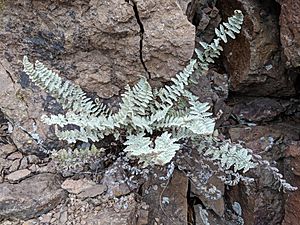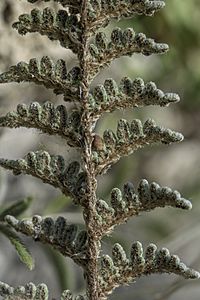Eaton's lip fern facts for kids
Quick facts for kids Eaton's lip fern |
|
|---|---|
 |
|
| Myriopteris rufa growing in typical rocky habitat | |
| Conservation status | |
| Scientific classification | |
| Genus: |
Myriopteris
|
| Species: |
rufa
|
| Synonyms | |
|
|
Myriopteris rufa, also known as Eaton's lip fern, is a medium-sized fern found in Mexico and the southwestern United States. You can also find smaller groups of these ferns in Costa Rica and the Appalachian Mountains. This fern was once part of the Cheilanthes genus, called Cheilanthes eatonii. However, since 2013, it has been placed in its own genus, Myriopteris. Eaton's lip fern usually grows in rocky places, often on limestone, but sometimes on basalt or shale rocks.
Contents
What Does Eaton's Lip Fern Look Like?
The fern has a compact, underground stem called a rhizome, which is about 3 to 8 mm (0.1 to 0.3 in) thick. Its leaves grow close together along this stem. The rhizome has scales that are about 3 to 4 mm (0.1 to 0.2 in) long. These scales are usually straight and lie flat against the rhizome. They have a dark reddish-brown or black center with light brown edges.
How Big Are Its Leaves?
The fern's leaves, called fronds, grow in groups from the rhizome. Unlike many ferns, they don't start as tightly coiled "fiddleheads." When fully grown, the fronds are 6 to 38 cm (2.4 to 15 in) long and 1.5 to 5 cm (0.6 to 2.0 in) wide. The stipe (the leaf stalk) is 3 to 16 cm (1.2 to 6.3 in) long. It is usually dark brown and covered with many small, tan or white scales.
What About the Leaf Blade?
The main part of the leaf, called the blade, is shaped like a narrow spear. It is divided into many smaller parts, sometimes two or three times. Each blade has about 12 to 18 pairs of these smaller sections. The tip of the blade is pointed, and the base is blunt or flat. The main stem of the leaf (the rachis) is dark brown and has soft hairs and scales.
The smallest parts of the leaf are round or bead-like, about 1 to 3 mm (0.04 to 0.12 in) long. The top surface of the leaf can have fine, white to rusty, curly hairs. The underside of the leaf is covered with a thick, woolly mat of curly reddish-brown hairs.
How Does It Reproduce?
On fertile fronds, the edges of the leaf curl over slightly. This protects the sori (clusters of spore-producing structures) on the underside. The sori form a continuous line around the edge of the bead-like leaf segments. Each sporangium (spore case) in a sorus contains 32 brown spores.
This fern reproduces in a special way called apogamy. This means it can create new plants without needing two parents. The spores are formed by a process called mitosis, which makes them genetically identical to the parent plant. These spores then grow into new ferns without needing fertilization.
Eaton's lip fern is very similar to another fern, Myriopteris tomentosa. You can tell them apart by looking at the scales under the leaf stem. M. rufa has distinct, spear-shaped scales, while M. tomentosa has more hair-like scales.
Why Is It Called Eaton's Lip Fern?
The common name "Eaton's lip fern" honors Daniel Cady Eaton, a scientist who studied ferns. The "lip fern" part comes from how the spore clusters (sporangia) are located at the edge or "lip" of the leaf. This is a common feature for ferns that used to be grouped under the name Cheilanthes.
How Did It Get Its Scientific Name?
The species was first described in 1857 by Antoine Laurent Apollinaire Fée. He named it Myriopteris rufa. The word rufa means "reddish," which might refer to the reddish color of the leaf stalk.
Later, many scientists considered Myriopteris to be part of the Cheilanthes genus. So, in 1861, Thomas Moore moved the fern to Cheilanthes. Since the name Cheilanthes rufa was already taken by another plant, he renamed it Cheilanthes schaffneri, after Johann Wilhelm Schaffner, who collected the first samples.
In 1867, John Gilbert Baker described a new species, Cheilanthes eatonii, based on ferns found in Texas. He named it after Daniel Cady Eaton, who helped identify American fern species. For many years, Cheilanthes eatonii was the widely accepted name for this fern.
Over time, scientists noticed that different forms of this fern, like those with less hair on the upper surface, were sometimes called different species, such as Cheilanthes castanea. However, many experts eventually agreed that these were all just variations of the same species.
Why Did the Name Change Again?
In recent years, scientists started using new methods, like studying the DNA of plants. These studies showed that the traditional way of grouping ferns in Cheilanthes was not quite right. Many ferns that looked similar had actually evolved those features independently.
Because of this new evidence, in 2013, scientists Amanda Grusz and Michael D. Windham brought back the genus Myriopteris for a group of ferns that were previously in Cheilanthes. This meant that Eaton's lip fern went back to its oldest name, M. rufa.
Further DNA studies have helped scientists understand the relationships between different Myriopteris species. M. rufa belongs to a group of ferns that have finely divided, bead-like leaf segments.
Where Does Eaton's Lip Fern Grow?
Myriopteris rufa is found in the southwestern United States, including Texas, Oklahoma, Arizona, and Utah. It also grows south through northern and eastern Mexico. You can also find separate groups of these ferns in the Appalachian Mountains (Virginia and West Virginia) and in Costa Rica.
This fern grows on the ground or on rocky slopes and ledges. It prefers limestone rocks but can also be found on basalt or shale. It grows at elevations from 300 to 3000 m (980 to 9,800 ft) high. In some areas, like northeast Texas, it grows on isolated rocky spots, sometimes on "iron ore rocks."
Is Eaton's Lip Fern Protected?
Overall, Eaton's lip fern is considered a secure species globally. However, it is rare or at risk in some states at the edge of its range. For example, it is only known from historical records in Arkansas. In Virginia and West Virginia, it is considered "imperiled" (meaning it's in great danger), and in Colorado, it is "vulnerable."
Can You Grow Eaton's Lip Fern?
Yes, this fern is easy to grow in gardens. It needs a lot of light and soil that drains well, mixed with sand. The soil should be dry to slightly moist.
Images for kids




